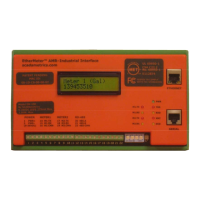
Do you have a question about the SCADAmetrics EtherMeter and is the answer not in the manual?
| Brand | SCADAmetrics |
|---|---|
| Model | EtherMeter |
| Category | Gateway |
| Language | English |
Lists essential skills for setting up and troubleshooting the EtherMeter.
Lists necessary tools for installing and troubleshooting the EtherMeter.
Lists tools required for attaching the EtherMeter to a DIN-rail.
Details supported meter communication protocols and parameters.
Outlines serial port types, speeds, parameters, and supported protocols.
Describes Ethernet port speed, addressing, and supported protocols.
Covers physical dimensions, weight, power, and environmental ratings.
Details the functionality and types of auxiliary I/O ports.
Lists safety, emissions, and compliance standards the device meets.
Provides crucial safety guidelines and warnings for operating the EtherMeter.
Lists environmental factors to consider for safe and efficient operation.
States compliance with FCC rules for Class A digital devices.
States compliance with Canadian ICES-003 for digital apparatus.
Illustrates the physical connections for various interfaces.
Explains the function of each DIP switch for configuration.
Describes how to adjust the LCD contrast for readability.
Discusses compatibility with various encoder-based flow meter protocols.
Details compatibility with different types of pulse-based flow meters.
Highlights key considerations for Sensus protocol connections.
Provides wiring terminal and color guidance for Sensus Channel 1.
Provides wiring terminal and color guidance for Sensus Channel 2.
Highlights key considerations for Neptune protocol connections.
Provides wiring terminal and color guidance for Neptune Channel 1.
Provides wiring terminal and color guidance for Neptune Channel 2.
Highlights key considerations for K-Frame protocol connections.
Provides wiring terminal and color guidance for K-Frame Channel 1.
Provides wiring terminal and color guidance for K-Frame Channel 2.
Lists the types of pulse inputs supported by the EtherMeter.
Guides on configuring pulse meter input via serial or Telnet.
Explains the debounce filter for mitigating contact bounce in pulse inputs.
Describes batching operations and pulse count reset methods.
Warns about misidentifying serial and Ethernet ports to prevent damage.
Details the RS-232C serial port configuration and adapters.
Details the RS-485 serial port, termination, and common reference.
Describes the Ethernet port capabilities and supported protocols.
Explains the energy-saving feature for solar-powered applications.
Describes the functionality and type of digital inputs.
Describes the functionality and type of digital outputs.
Details the configuration and wiring for Analog Input 1.
Details the configuration and wiring for Analog Input 2.
Shows the correct wiring method for analog inputs.
Illustrates common incorrect wiring for analog inputs.
Provides an example of EtherMeter deployment as a standalone RTU.
Introduces the setup menu structure and navigation.
Configuration screen for meter units, timebases, and scaling.
Configuration for serial port protocol, baud rate, and parameters.
Configuration for IP address, gateway, netmask, and ports.
Configuration for auxiliary digital and analog I/O settings.
Configuration for LCD display content and meter descriptions.
Real-time display of MODBUS/DF1 registers for Meter 1 and Meter 2.
Real-time display of auxiliary I/O and flow status in MODBUS/DF1.
Displays diagnostic information for meter readings.
Detailed commands for configuring meter-specific settings.
Commands for configuring pulse meter parameters like debounce and counts.
Commands for configuring serial port behavior and flow control.
Commands for managing serial port collision avoidance.
Settings for modifying serial reception behavior.
Commands for configuring Modbus, DF1, and network settings.
Commands for configuring auxiliary I/O functions and timing.
Commands for configuring analog input scaling and conversion.
Commands to control which data is displayed on the LCD.
Commands to control display of I/O, protocol, address, uptime, and firmware.
Commands to set meter descriptions and a device banner.
Lists the Modbus function codes supported by the EtherMeter.
Shows a screenshot of the Simply Modbus TCP client.
Provides a map of Modbus registers and their descriptors.
Explains the contents of the Digital Status Bits register.
Illustrates a typical Modbus request and response transaction.
Provides examples of common Modbus/RTU commands.
Describes how totalization and flow data is formatted in Modbus.
Provides formulas for calculating totalized values from register data.
Provides formulas for calculating flow rates from register data.
Illustrates an example of meter totalization and flow data.
Details the EtherMeter's support for Rockwell Automation's DF1 protocol.
Lists DF1 registers and their corresponding functions.
Explains the EtherMeter's support for the EtherNet/IP protocol.
Illustrates EtherNet/IP request/response for unconnected messaging.
Illustrates EtherNet/IP request/response for connected messaging.
Describes DF1 data format and provides totalization/flow helper formulas.
Illustrates an example of DF1 totalization and flow data.
Lists the subset of ADAM-4000 protocol functions supported.
Provides a map of ADAM-4000 registers and their descriptors.
Describes ADAM-4000 data format and provides helper formulas.
Illustrates an ADAM-4000 request and response.
Explains data formatting and transmission in Raw ASCII protocol.
Lists the screens displayed in repeating rotation for serial displays.
Provides mounting dimensions and notes for external displays.
Shows the wiring diagram for connecting a serial display.
Shows a screenshot of the EtherMeter's web server interface.
Displays a snapshot of data served by the EtherMeter web server.
Illustrates an example of a custom, frame-based web page.
Provides the HTML source code for the example web page.
Shows examples of Telnet client sessions for accessing the EtherMeter.
Advises on using firewalls for network protection.
Lists manufacturers of compatible meter registers.
Provides links to specifications for industrial communication protocols.
Lists sources for auxiliary devices like isolation modules and relays.
Lists recommended third-party software for testing and emulation.
Outlines the general terms, duration, and scope of the limited warranty.
Explains the procedure for obtaining warranty service and required information.
Details the process for warranty repair or replacement of defective components.
Lists limitations, exclusions, and disclaimers applicable to the warranty.
Specifies the governing law for the limited warranty.
Covers licensing terms, restrictions, and warranty for the firmware.